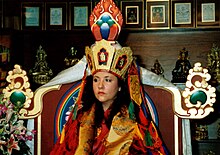Western tulku
[4][5] The term "tulku" in Tibetan Buddhism corresponds to the Sanskrit "nirmāṇakāya" and represents the physical form in which a Buddha appears to ordinary beings.
[7] A related concept, "yangsi," denotes an enlightened master who has returned to earthly existence for the benefit of sentient beings.
[8] The tulku system emerged during a historical period marked by a political vacuum in Tibet following the assassination of Ralpachen.
Despite its political origins,[9] the tulku system possesses essential ideological and religious dimensions, deeply connected to the bodhisattva concept.
[9] Foreign tulkus have been identified since at least the sixteenth century, when the grandson of the Mongol Altan Khan was recognized as the 4th Dalai Lama.
This intensified during the Cultural Revolution which brought irreparable damage to the institutions and traditions which constitute Tibetan Buddhism as one of the Four Olds.
[14] Compounded with the inherent transnational character of proselytizing religions, Tibetan Buddhism is "pulled between the need to adapt itself and the need to preserve itself" in the face of Chinese occupation and Western fascination with Tibet (cf.
[19][20] The first recognized white tulku was Dylan Henderson, an American boy identified as his father's teacher, or alternatively Ossian MacLise (born in Kathmandu, Nepal).
"[30] Seagal is involved in the international arms trade and the government of Russia,[31] which has prompted criticism of his title by English journalist Marina Hyde.
[40] Raymond Lee and Susan Ackerman argue that the recognition of Western tulkus "enhances the image of the Tibetan hierocracy as being open to change", occurring in a critical moment and "market-like situation that thrives on syncretic ideas and practices.
[45] Norbu himself is critical of the place of Buddhism in the Tibetan exile community, as well as the "whimsies of western dharma-types, enamoured with everything 'traditional' or 'mystical' in Tibet.

